Early Detection of Cardiotoxicity Biomarkers with an Ultrasensitive Biomarker Detection Platform
Research on the early detection of cardiotoxicity biomarkers is critical to help prevent life-threatening cardiac events. The measurement of serum cardiac troponins is the gold standard for the diagnosis of acute myocardial events in humans and it has gained increasing recognition as a new tool for the assessment of cardiotoxicity in safety studies. Due to its unique high-definition technology, elevated levels of cardiac troponin I (cTnI) in serum can be detected earlier with the ultrasensitive biomarker detection Single Molecule Counting (SMC®) immunoassay technology. Discover the utility of SMC® technology and the SMC® Human cTnI High Sensitivity Immunoassay Kit for early assessment of heart muscle injury in rats.
Understanding the Cardiac Troponin Complex
Cardiac troponin-I (cTnI) is specific to cardiomyocytes and is released into the bloodstream following heart damage. Extensive studies have shown that cTnI is slowly released from damaged cardiomyocytes. This has allowed cTnI to become widely accepted in preclinical and clinical drug development settings as an indicator of myocardial damage and hence, heart damage.
The value of cardiac troponins I and T (cTnI and cTnT) in the assessment of acute myocardial damage resides in the unique functional characteristics of these proteins that, along with cardiac troponin C, form a cardiac troponin complex bound to the myofibril of striated (skeletal and cardiac) muscles (Figure 1).
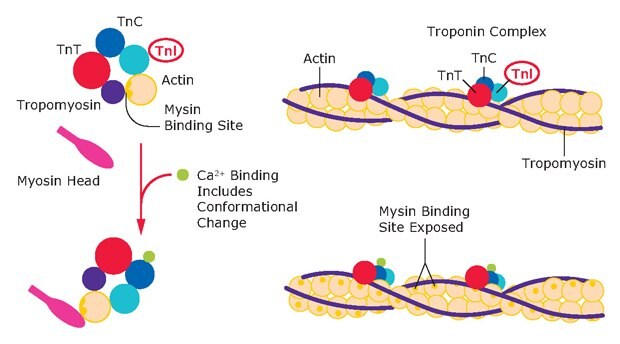
Figure 1.The cardiac troponin complex consists of Troponin- I (TnI), Troponin-T (TnT), and Troponin-C (TnC). These act as a complex that binds to tropomyosin and actin myofibrils. The troponin complex regulates muscle contraction via conformational changes that are induced after calcium binding.
In addition to this myofibril-bound pool, there is a small cytoplasmic pool that most probably serves as a precursor pool for the cardiac troponin (cTn) complex. After myocardial damage, the cytoplasmic pool is hypothesized to be rapidly released while myofibril-bound cTnI is gradually degraded through proteolysis and released as fragments and portions of the original complex.
Evaluating Safety Profiles with SMC® Technology
In this particular study, the effects of various chemical compound classes on cTnI levels were investigated. Two previously known cardiotoxins (isoproterenol and hydralazine), as well as two drug classes with controversial safety profiles – tyrosine kinase inhibitors (TKIs, imatinib) and peroxisome proliferator-activated receptor-gamma (PPARγ) agonists (rosiglitazone), were tested. All of these demonstrated significant cTnI elevations, thus demonstrating the utility of the SMC® Human cTnI High Sensitivity Immunoassay Kit and the SMC® biomarker detection technology for evaluating the safety profile of candidate drugs.
As increases in cTnI levels often precede observable cardio pathology, it is inherently important to be able to detect serum cTnI level increases above endogenous levels as early as possible. The SMC® technology has unique high-definition capabilities that can detect elevated levels of cTnI in serum samples earlier (Table 1).
Currently, in toxicology studies, cTnI is measured on systems developed for use in hospital settings. These systems lack the necessary sensitivity, having lower limits of quantification (LLOQ ≥ 30 pg/mL) that are not capable of detecting the healthy range of baseline cTnI values in rats (Table 2).
Recently, there has been an expansion of highly sensitive troponin assays. These assays have increased sensitivity compared to traditional assays, and have reduced the limit of detection (LOD) in some cases to the sub-picogram level. At the forefront is the high-definition SMCxPRO® immunoassay system, which utilizes Single Molecule Counting (SMC®) technology to provide extreme sensitivity. This sensitivity offers the ability to monitor very low basal cTnI levels against which small cTnI elevations can be evaluated, resulting in early recognition of toxicity.
The SMC® Human cTnI High Sensitivity Immunoassay Kit is the first high-definition assay for cardiac troponin-I, with a LOD of 0.1 pg/mL and an LLOQ of 0.69 pg/mL, that are orders of magnitude more sensitive than prior troponin assays. This 30-100-fold increase in sensitivity over previously employed systems has enabled the identification of accurate and robust baseline cTnI values for a variety of species including human, dog, monkey, rat (Table 2), and guinea pig.
Additional studies have determined baseline reference ranges (Figure 2A) and biological variability (Figure 2B) of cTnI in healthy control rats.
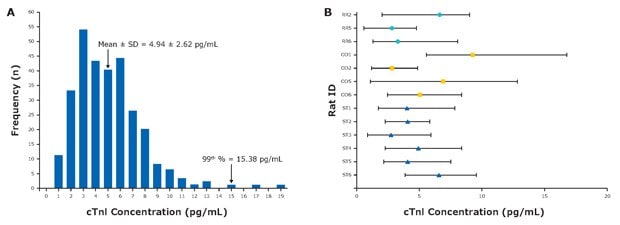
Figure 2.Baseline distribution and biological variability of cTnI in healthy control rats. (A) Distribution of cTnI, mean ± SD and 99th%. (B) Biological variability of cTnI over 24 hours, mean and absolute range. Abbreviations: RR, resting rats; OD, oral dose saline; ST, simulated transport. Adapted from Schultze et al., 2009 2.
Study Objectives
- To investigate pre-clinical cardiotoxicity of several therapeutic compound classes utilizing the high-definition SMC® cTnI immunoassay.
- To verify the utility of the SMC® cTnI assay for improving the safety profile of candidate drugs by detecting the minute release of cTnI from cardiomyocytes at earlier study time points or lower therapeutic doses and before the physiological changes can be detected.
These values are surprisingly consistent with studies in humans, concerning both the healthy reference range values (Figure 3A)3 and biological variability in human clinical studies (Figure 3B)4.
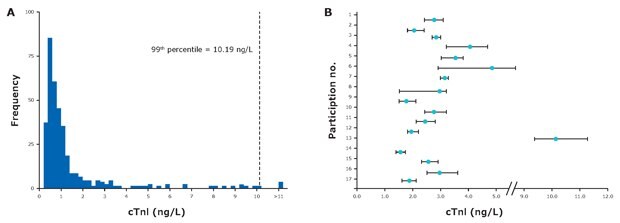
Figure 3.Baseline distribution and biological variability of cTnI in human clinical studies. (A) Baseline references ranges of healthy blood donors measured with the SMC® cTnI immunoassay (adapted from Apple et al, 2010)3. (B) Long term biological variability of cTnI in baseline subjects measured with the SMC® cTnI immunoassay over 8 days (adapted from Wu et al, 2009) 4.
While it has been generally accepted that troponin increases identified by the earlier, less sensitive assays are indicative of cellular cardiac damage, the exact biological significance of previously undetectable cTnI increases above baseline is currently a hot topic of clinical investigation.
PPARγ agonists (e.g., rosiglitazone, Avandia) have been reported to elicit adverse cardiac events in a subset of patients. Other classes of therapeutic compounds, like tyrosine kinase inhibitors (TKIs) and statins, may also need more sensitive evaluations for cardiotoxicity. For these classes of compounds, more sensitive methods for detecting low-grade damage to cardiomyocytes have the potential to guide decision making during clinical and pre-clinical drug development.
Evaluation Methods
cTnI Assays
Cardiac troponin-I was measured using the SMC® high-sensitivity immunoassay system. In some cases (isoproterenol and rosiglitazone studies), samples were also tested using the AccuTNI™ Access® 2 Immunoassay System (Beckman Coulter, Fullerton, CA) for comparison.
Isoproterenol
Male Fischer 344 rats (F344/NHsd) aged 5 to 6 weeks were divided into groups (n=5 rats each) and given single subcutaneous injections of vehicle or isoproterenol (0.5 or 8 mg/kg). Rats were sampled at 0.25, 0.5, 1, 2-, 4-, 8-, or 24-hours post-dose. Rats were anesthetized, bled, humanely euthanatized, and tissues were processed for histopathologic examination.
Hydralazine
Male Han Wistar (Crl:WI(Han)) aged 8 weeks were given intravenous injections of hydralazine (25 mg/ kg). Single doses (1x) were administered, and rats were sampled at 6, 24, and 48 hours after dosing. Double doses (2x) were administered 24 hours apart, and rats were sampled at 6 and 24 hours after the second dose.
Rosiglitazone
Male Han Wistar rats (Crl:WI(Han)) were aged 9 weeks (10/group) and sampled at four time-points: 6 hours, 24 hours, 7 days, and 14 days. Dosed rats were treated with an oral dosing regimen of vehicle control, 10 mg/kg or 80 mg/kg per day of rosiglitazone. Samples were frozen at -70°C for 2 years and re-evaluated for cTnI with the SMC® cTnI assay.
Imatinib (IMB)
Groups of adult male Sprague Dawley (SD) or spontaneously hypertensive rats (SHR) were treated with 50 mg/kg (n=5) or 100 mg/kg (n=10) IMB or water (n=10) daily (by mouth) for 14 days. For comparison, a dose of 100 mg/kg is approximately 2x the recommended human dose of 600 mg/m2. Tissues and blood samples were collected 24 hours after the last dosing.
Cardiotoxicity Testing Results
To first establish the utility of the SMC® Human cTnI High Sensitivity Kit and its immunoassay system for cardiotoxicity testing, a direct comparison was made versus the Access AccuTNI™ assay offered by Beckman Coulter.
The Access AccuTNI™ panel is currently being used in hospital-based settings as well as for cardiotoxicity testing in clinical and pre-clinical applications, and thus was used as a concordance method. For this application, cTnI levels were measured after administration of isoproterenol and hydralazine, two known cardiotoxic compounds.
Isoproterenol
Concentrations of cTnI in serum samples were measured after administration of isoproterenol in rats 1. cTnI was measured using the 2.5 μL serum (Erenna® platform) and 140 μL serum (Beckman Coulter) samples in the respective immunoassays. All samples measured with the SMC® cTnI assay were quantifiable at each time interval tested and in all animals of the study, including pre-dose baseline animals (10/10). Whereas only 3 of 10 pre-dose rats were measurable with the Access AccuTNI™ assay. As early as fifteen minutes post-administration, marked increases from baseline cTnI values, followed by decreases after 4 hours, were observed (Figure 4). The cTnI values obtained for identical specimens using the Beckman Coulter Access AccuTNI™ assay are presented for comparison to the SMC® values.

Figure 4.Rat cTnI concentrations measured by the Erenna® platform (2.5 µL; shown as “Singulex” in the graph) and Beckman Coulter (140 µL; shown as “Beckman” in the graph) cTnI assays after administration of isoproterenol at (A) 0.5 mg/kg and (B) 8 mg/kg. Adapted from Schultze et al, 2008 1.
Hydralazine
Having established the functionality of the SMC® cTnI assay, another known cardiotoxin, hydralazine, was evaluated. However, not only was serum cTnI measured but correlate histopathology was compared as further verification of the assay. A single dose of hydralazine caused an increase of cTnI at 6 hours post-dose, followed by a decrease at 24 hours, and a return to baseline values by 48 hours (Figure 5). Elevated values of cTnI coincided with acute myocardial necrosis at histology. However, elevated cTnI levels were observed in the absence of histopathologic lesions in multiple rats, and preceded the development of histopathologic changes in the heart that matured to cardiomyopathy 5.
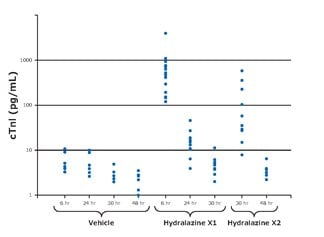
Figure 5.Individual serum cTnI concentrations in rats after vehicle control (saline) or one or two doses of hydralazine (25 mg/kg). Adapted from Mikaelian et al, 2009 5.
Earlier Cardiotoxicity Detection Results
Next, the SMC® cTnI assay and its immunoassay platform were analyzed for cardiotoxicity testing of compounds with controversial cardiotoxicity profiles in humans to determine if earlier cardiotoxicity could be detected in animal models using this more sensitive assay methodology. Two drug classes were tested – tyrosine kinase inhibitors (TKIs, imatinib) and peroxisome proliferator-activated receptor-gamma (PPARγ) agonists (rosiglitazone). The SMC® immunoassay system was used to measure cTnI levels to demonstrate the utility of high-definition technology for earlier and more sensitive evaluations of cardiotoxicity that can improve the safety profile of candidate drugs.
Rosiglitazone
As noted above, it is important to quantify all study time points – including basal, endogenous levels –to elucidate early and subtle elevated cTnI levels that often fall below the nominal detection limits of current platforms and techniques. A noteworthy example is rosiglitazone, a drug in a class with a controversial safety profile.
The SMC® Human cTnI High Sensitivity Kit was used to analyze the sera of rats given rosiglitazone for up to 14 days (Figure 6) 6. All samples, whether treated or not, assayed with the Beckman Coulter Access® 2 AccuTNI™ assay were below LLOQ and therefore could not be measured. In contrast, the Erenna® Immunoassay System using SMC® technology identified significant drug-induced cTnI increases. At the 80 mg/kg/day dose, cTnI levels as measured by the SMC® assay increased approximately 5-fold in 5 of 9 rats on day 7, returning to control levels on day 14 (Figure 6).
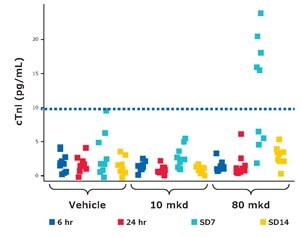
Figure 6.Rat cTnI concentrations as measured by the SMC® assay increase above baseline value (dotted line; unpublished data) on day 7 (SD7) in 5/9 rats given 80 mg/kg/day (mkd) rosiglitazone. Adapted from Hirkaler et al, 2010 6.
Imatinib (IMB)
Similar to rosiglitazone, IMB has some controversy surrounding its safety profile. IMB is an interesting class due to its influence on a concomitant disease, hypertension. Notwithstanding the anti-hypertensive effects, the cardiotoxic effects of IMB in hypertensive rat strains were analyzed 7. Increased serum levels of cTnI were detected in all IMB-treated groups (Figure 7). The overall levels were higher in spontaneously hypertensive (SHR) rats (31.5±24.0, 41.3±29.0, and 53.9±12.3 pg/ml) compared to Sprague-Dawley (SD) rats (6.80±5.7, 25±20, and 30±25 pg/ml) at the control, 50, and 100 mg/kg doses, respectively.
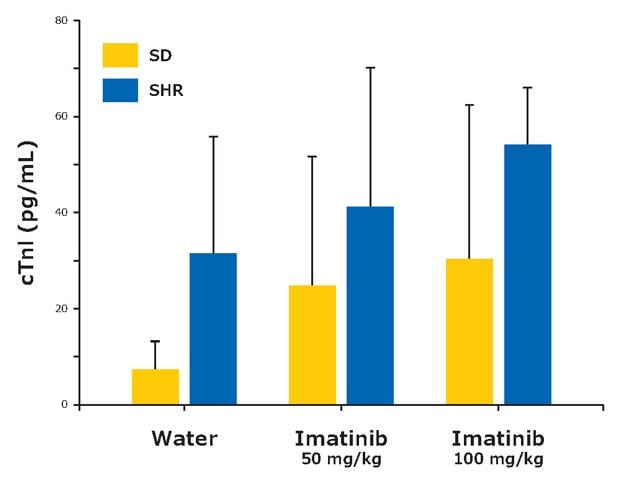
Figure 7.Serum cTnI concentrations in SD (yellow) and SHR (blue) rats following administration of water or imatinib (50 or 100 mg/kg) for 14 days. Results are shown as mean ± SD. Adapted from Herman et al, 2010 7.
Observed increases in serum cTnI corresponded to the presence of dose-dependent cardiac lesions, which were characterized by cytoplasmic vacuolization, myofibrillar loss, interstitial infiltration with chronic inflammatory cells, and fibrosis (proliferation of myofibroblasts). These results indicate that hypertension, as expressed in SHR rats, appears to be a factor that can intensify the cardiotoxic effects of IMB and that monitoring for cardiac troponin I may provide a sensitive means of detecting IMB toxicity.
Summary
This shows the application of SMC® technology towards the early assessment of cardiotoxicity. The SMC® Human cTnI High Sensitivity Kit is a significant improvement over traditional methods of cardiotoxicity testing and is the only high-definition assay that can quantify minute concentrations of cTnI in serum samples from healthy, baseline animals. This capability is essential for detecting the minute release of cTnI molecules from cardiomyocytes in toxicity studies at earlier study time points, lower therapeutic doses, and before physiological changes can be detected.
The data shown demonstrates the use of the SMC® cTnI assay for safety testing in rats of various classes of chemical compound classes, including two previously known cardiotoxins (isoproterenol, hydralazine), as well as two drug classes with controversial safety profiles - TKIs (imatinib) and PPARγ agonists (rosiglitazone).
With ultrasensitive SMC® technology, increases in serum cTnI are detected earlier and precede observable cardio pathology. These studies indicate that serum cTnI is a more sensitive biomarker than histopathology for identifying acute myocardial damage in preclinical rat models of cardiotoxicity.
In conclusion, cTnI measured by the SMC® immunoassay was more sensitive than histopathology and other clinical platforms currently available to identify acute cardiotoxicity. It has the potential to guide decision making during pre-clinical and clinical drug development, demonstrating the utility of the SMC® cTnI assay for improving the safety profile of candidate drugs.
Materials
For Research Use Only. Not For Use In Diagnostic Procedures.
References
To continue reading please sign in or create an account.
Don't Have An Account?